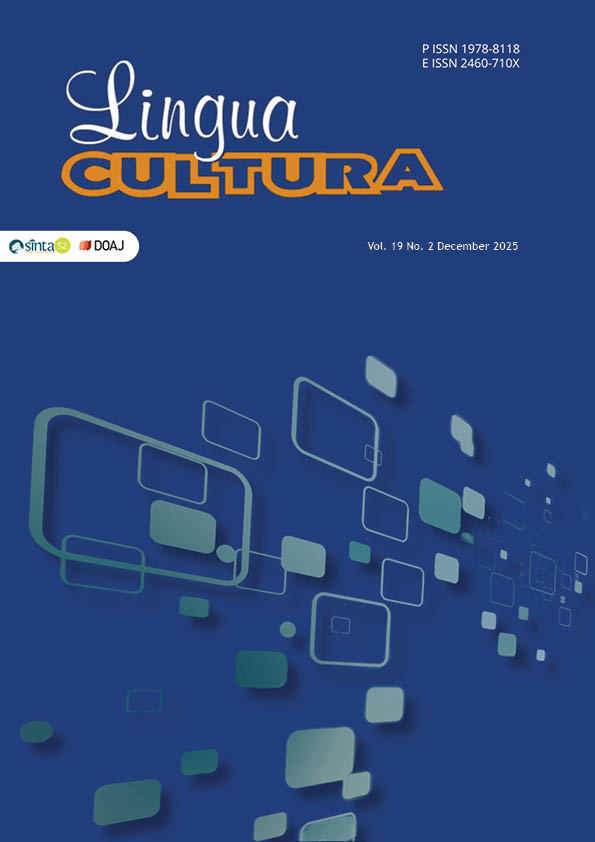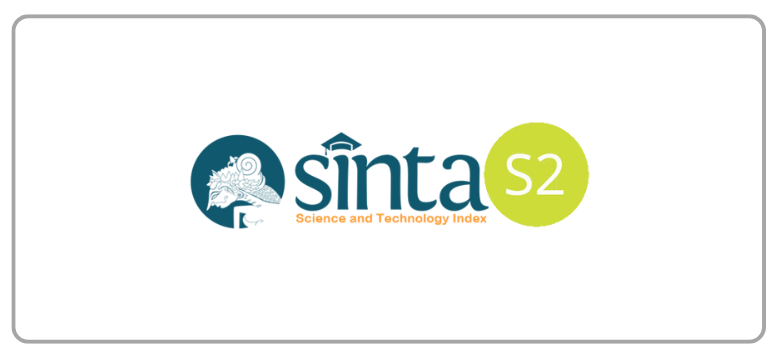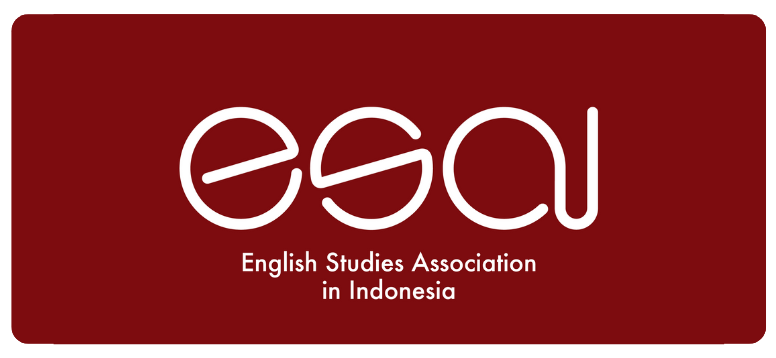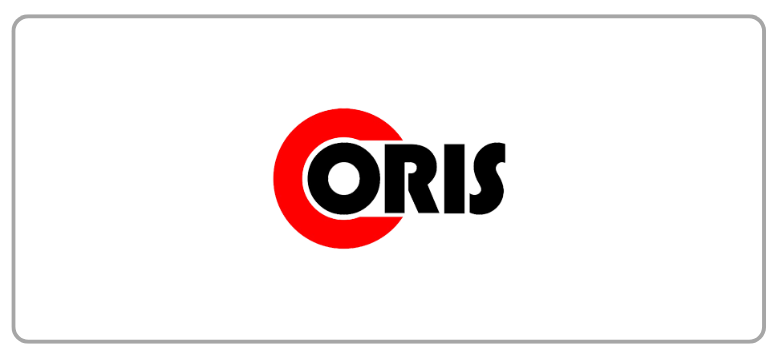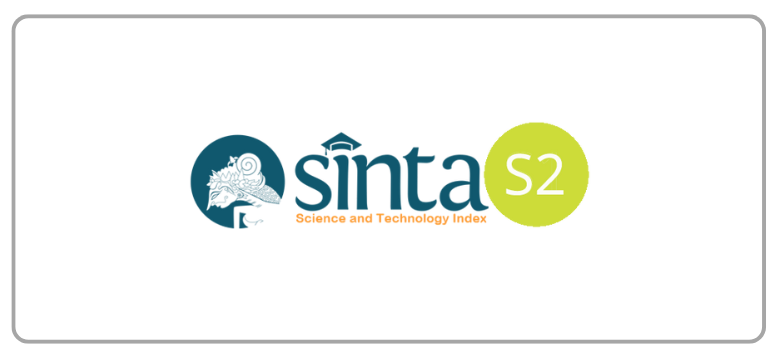Conceptual Metaphor of Anxiety: Cognitive Linguistic Perspectives in Buzz Album By NIKI
Keywords:
anxiety, Buzz album, cognitive linguistic, conceptual metaphor, image schemaAbstract
This study investigates the conceptual metaphor of anxiety in Buzz, the third album by Indonesian singer NIKI, from a cognitive linguistic perspective. Anxiety, as a blended emotional and cognitive experience, is often difficult to articulate directly, and metaphor provides a means to externalize such subjective states. This research analyzes how metaphorical expressions in NIKI’s lyrics conceptualize anxiety and how these are structured through image schemas. Using a qualitative descriptive method, the data were obtained from 13 songs in the album and transcribed into narrative texts. From 462 lines of lyrics, 66 metaphorical expressions were identified, and 16 of them were classified as anxiety-related metaphors. The analysis employs Conceptual Metaphor Theory (Lakoff & Johnson, 2003) and Image Schema Theory (Clausner & Croft, 1999) to examine the cognitive mappings involved. The findings reveal five metaphorical concepts of anxiety: ANXIETY IS EFFORT, PAIN, RELATION, PROTECTION, and DIRECTION, which are realized through image schemas such as FORCE, CONTAINER, SPACE, EXISTENCE, and UNITY. The dominant schema, SPACE, reflects the spatial orientation and instability associated with emotional disorientation. These results demonstrate that metaphor in song lyrics not only enhances aesthetic expression but also serves as a cognitive tool for expressing internal psychological struggles. This study contributes to cognitive linguistics by offering insight into how complex emotions like anxiety are represented in contemporary music discourse. This insight may inform mental health awareness and highlight music’s role in helping listeners process and articulate emotional experiences.
References
Ajayi, D. O. (2023). ‘Living things’: Metaphor and urban youth culture in Abolore Akande Adigun’s (9ice) hip hop music. African Identities, 21(1), 48–65. https://doi.org/10.1080/14725843.2020.1828040
Azlinda, V., Santoso, A., & Susilowati, N. E. (2022). Potret metafora konseptual dalam album lagu-lagu Denny Caknan. JoLLA: Journal of Language, Literature, and Arts, 2(5), 658–675. https://doi.org/10.17977/um064v2i52022p658-675
Barlow, D. H. (1991). Disorders of emotion. Psychological Inquiry, 2(1), 58–71. https://doi.org/103.121.246.130
Budiawan, R. Y. S., & Viani, Y. O. (2022). Metafora konseptual pada album Manusia karya Tulus. Prosiding PIBSI Ke-44 Universitas PGRI Yogyakarta.
Casline, E. P., Ginsburg, G. S., Piacentini, J., Compton, S., & Kendall, P. (2021). Negative life events as predictors of anxiety outcomes: An examination of event type. Research on Child and Adolescent Psychopathology, 49(1), 91–102. https://doi.org/10.1007/s10802-020-00711-x
Clausner, T. C., & Croft, W. (1999). Domains and image schemas. Cognitive Linguistics, 10(1), 1–31. https://doi.org/0936-5907/99/0010-0001
Danial, M. H. A., & Widyawati, W. (2024). Metaphor in the song lyrics of Aurora’s album: A different kind of human step 2. Aqlamuna: Journal of Educational Studies., 2(1), 91–118. https://doi.org/10.58223/aqlamuna.v2i1.369
Daly, R. (2024, July 31). Indonesian star NIKI talks her forthcoming third album “BUZZ” • In Deep • DIY Magazine. https://diymag.com/in-deep/niki-buzz
Devita, A. A., & Nur, T. (2020). Metafora konseptual dalam Lukas Graham 3 the purple album: Analisis semantik kognitif. Semantik, 9(2), 85–92. https://doi.org/10.22460/semantik.v9i2.p85-92
Dirgaprimawan, B. (2023). Wisdom is a tree of life (Prov. 3:18): A conceptual metaphor. Diskursus, 19 (1), 79–92. https://doi.org/10.36383/diskursus.v19i1.357
Farina, E., & Pepe, A. (2024). Metaphors of adolescence during COVID-19 pandemic: A mixed-method analysis in relation to well-being and alexithymia. Frontiers in Psychology, 15. https://doi.org/10.3389/fpsyg.2024.1355752
Fauzan, M., Aibonotika, A., & Rahayu, N. (2023). Metafora Konseptual pada Lirik Lagu Soundtrack Anime “Fullmetal Alchemist: Brotherhood”: Kajian Semantik Kognitif. J-Litera: Jurnal Kajian Bahasa, Sastra, dan Budaya Jepang, 5(1), 28–34.
Fitria, L., & Ifdil, I. (2020). Kecemasan remaja pada masa pandemi Covid -19. Jurnal EDUCATIO: Jurnal Pendidikan Indonesia, 6(1), 1. https://doi.org/10.29210/120202592
Gu, Y., Gu, S., Lei, Y., & Li, H. (2020). From uncertainty to anxiety: How uncertainty fuels anxiety in a process mediated by intolerance of uncertainty. Neural Plasticity, 2020, 1–8. https://doi.org/10.1155/2020/8866386
Gude, M. Y., Liliweri Aloysius, & Meilawati, F. T. (2023). Hubungan antara tingkat kecemasan berkomunikasi dengan kemampuan beradaptasi mahasiswa dalam masa pandemi. Deliberatio: Jurnal Mahasiswa Komunikasi, 3(2), 265–275. https://doi.org/10.59895/deliberatio.v3i2.166
Gustina, N. Z., Badri, I. A., & Putri, Y. D. (2023). Relationship between peer support with anxiety level of student in last term in Batam. Jurnal Riset Kesehatan Nasional, 7(2), 150–155. https://doi.org/10.37294/jrkn.v7i2.515
Hussain, M., Ali, A., & David, M. K. (2022). Conceptual metaphors in the hazaragi community’s institution of marriage in Balochistan, Pakistan. LingPoet: Journal of Linguistics and Literary Research, 3(3), 68–86. https://doi.org/10.32734/lingpoet.v3i3.9302
Hutagalung, N., & Ritonga, M. U. (2023). Analisis metafora pada lirik “Senandung Malam Berinai” tradisi suku melayu Percut Sei Tuan. Pediaqu: Jurnal Pendidikan Sosial dan Humaniora, 2(3), 11622–11628.
Irwansyah, N. (2021). Metafora konseptual cinta dalam lirik lagu Taylor Swift di album 1989. SUAR BETANG, 16(1), 49–64. https://doi.org/10.26499/surbet.v16i1.213
Jannah, R., & Istiqomah, K. (2021). Conceptual metaphor in Kahitna’s song lyrics. NOBEL: Journal of Literature and Language Teaching, 12(2), 199–213. https://doi.org/10.15642/NOBEL.2021.12.2.199-213
Kamandanu, I. K. R. J., Puspani, I. A. M., & Ni Ketut Alit Setianingsih. (2024). Analyzing conceptual metaphors through Michael Bublés ‘Call Me Irresponsible’ album. Austronesian: Journal of Language Science & Literature, 3(3), 113–121. https://doi.org/10.59011/austronesian.3.3.2024.113-121
Kovecses, Z. (2005). Metaphor in culture: Universality and variation. Cambridge University
Lakoff, George. (2003). Metaphors we live by. University of Chicago Press.
Liu, D., & Mo, Q. (2020). Conceptual metaphors and image schemas: A corpus analysis of the development of the on track/off track idiom pair. Journal of English Linguistics, 48(2), 137–165. https://doi.org/10.1177/0075424220912455
Luthfiani, A. A., & Kurniawati, W. (2024). Metafora konseptual dalam lagu-lagu Namika. E-Journal Identitaet, 13(2).
Massazza, A., Kienzler, H., Al-Mitwalli, S., Tamimi, N., & Giacaman, R. (2023). The association between uncertainty and mental health: A scoping review of the quantitative literature. Journal of Mental Health, 32(2), 480–491. https://doi.org/10.1080/09638237.2021.2022620
Mowrer, O. H. (1939). A stimulus response analysis of anxiety and its role as a reinforcing agent. Psychological Review, 46 (6), 553-565. https://doi.org/10.1037/h0054288
Nasution, A. A., Matanari, D. U., Fianda, A., Sasmita, R., & Rangkuti, R. (2024). Conceptual metaphor in Lonestar song lyrics “I’m already there”: A cognitive stylistic analysis. Humanitatis : Journal of Language and Literature, 10(2), 459–468. https://doi.org/10.30812/humanitatis.v10i2.4070
Nwankwo, J. C., & Nagornaya, A. (2024). Therapeutic potential of twenty-first century music for cancer survivorship: From music and conceptual metaphor perspectives to a synergetic effect approach. Supportive Care in Cancer, 32(8), 520. https://doi.org/10.1007/s00520-024-08719-5
Prasetya, D. B. Y., & Oesman, A. M. (2024). The cognitive linguistic analysis of conceptual metaphor in Yomiuri Shinbun and Asahi Shinbun on covid-19 discourses. Chi’e: Jurnal Pendidikan Bahasa Jepang, 12 (1), 51–63
Puteri, A. D., & Nur, T. (2024). Skema citra identitas pada metafora dalam lagu-lagu Kings of Convenience: Kajian semantik kognitif. Ilmu Budaya: Jurnal Bahasa, Sastra, Seni, dan Budaya, 8(1), 75. https://doi.org/10.30872/jbssb.v8i1.14019
Risthavania Putri, S., Yunianti, N., & Nurjanah, N. (2023). Metafora konseptual pada lirik lagu karya Fiersa Besari dan Feby Putri. Jurnal Ilmiah SEMANTIKA, 5(01), 40–48. https://doi.org/10.46772/semantika.v5i01.1146
Sangian, E. Z., & Nasution, V. A. (2024). The metaphorical meaning of the song Yo Botoi-Botoi in pasar Bengkulu. KREDO: Jurnal Ilmiah Bahasa Dan Sastra, 7(2), 364–373.
Sari, D. R. (2020). Conceptual metaphor of love in minang song composed by Syahrul Tarun Yusuf. Lingua Didaktika 13(2), 205-214 https://doi.org/10.24036/ld.v13i2.104909
Sari, N. A., & Nirmala, D. (2022). Conceptual metaphors of mental disorder issues (a cognitive linguistic study). ICHSS, 2, 535–546.
Shi, N., Zhang, D., Li, L., & Xu, S. (2021). Predicting mental health problems with automatic identification of metaphors. Journal of Healthcare Engineering, 2021, 1–11. https://doi.org/10.1155/2021/5582714
Suryadi, M., & Uctuvia, V. (2023). Conceptual metaphor of ‘heart’ in popular javanese love song. SEMIOTIKA: Jurnal Ilmu Sastra Dan Linguistik, 24(1), 11. https://doi.org/10.19184/semiotika.v24i1.36504
Taylor, S. J., Bogdan, R., & DeVault, M. (2015). Introduction to qualitative research methods: A guidebook and resource (1st ed.). Wiley. https://doi.org/10.1002/9781394260485
Tsamarah, H., Dwi Agustin, A. F., & Nurjanah, N. (2023). Analisis Metafora Yang Mengandung Makna Kemanusiaan Dalam Kumpulan Lagu Iwan Fals. ALINEA : Jurnal Bahasa, Sastra dan Pengajarannya, 3(2), 419–433. https://doi.org/10.58218/alinea.v3i2.631
Widyastuti, I. P., & Fateah, N. (2024). Metafora konseptual percintaan dalam lagu Didi Kempot berjudul Banyu Langit album Kasmaran. Belantika Pendidikan, 7(1), 29–37. https://doi.org/10.47213/bp.v7i1.360
Woodgate, R. L., Tennent, P., & Legras, N. (2021). Understanding youth’s lived experience of anxiety through metaphors: A qualitative, arts-based study. International Journal of Environmental Research and Public Health, 18(8), 4315. https://doi.org/10.3390/ijerph18084315
Vinh, V. H. (2025). An analysis of the conceptual metaphors in the song lyrics “Yesterday” by Paul Mccartney. International Journal of Scientific and Research Publications, 15(1), 13–17. https://doi.org/10.29322/ijsrp.15.01.2025.p15704
Yarrington, J. S., Metts, A. V., Zinbarg, R. E., Nusslock, R., Wolitzky-Taylor, K., Hammen, C. L., Kelley, N. J., Bookheimer, S., & Craske, M. G. (2023). The role of positive and negative aspects of life events in depressive and anxiety symptoms. Clinical Psychological Science, 11(5), 910–920. https://doi.org/10.1177/21677026221141654
Published
How to Cite
Issue
Section
License
Copyright (c) 2025 Istika Suri, Hermina Sutami

This work is licensed under a Creative Commons Attribution-ShareAlike 4.0 International License.
Authors who publish with this journal agree to the following terms:
a. Authors retain copyright and grant the journal right of first publication with the work simultaneously licensed under a Creative Commons Attribution License - Share Alike that allows others to share the work with an acknowledgment of the work's authorship and initial publication in this journal.
b. Authors are able to enter into separate, additional contractual arrangements for the non-exclusive distribution of the journal's published version of the work (e.g., post it to an institutional repository or publish it in a book), with an acknowledgment of its initial publication in this journal.
c. Authors are permitted and encouraged to post their work online (e.g., in institutional repositories or on their website) prior to and during the submission process, as it can lead to productive exchanges, as well as earlier and greater citation of published work.
USER RIGHTS
All articles published Open Access will be immediately and permanently free for everyone to read and download. We are continuously working with our author communities to select the best choice of license options, currently being defined for this journal as follows: Creative Commons Attribution-Share Alike (CC BY-SA)
